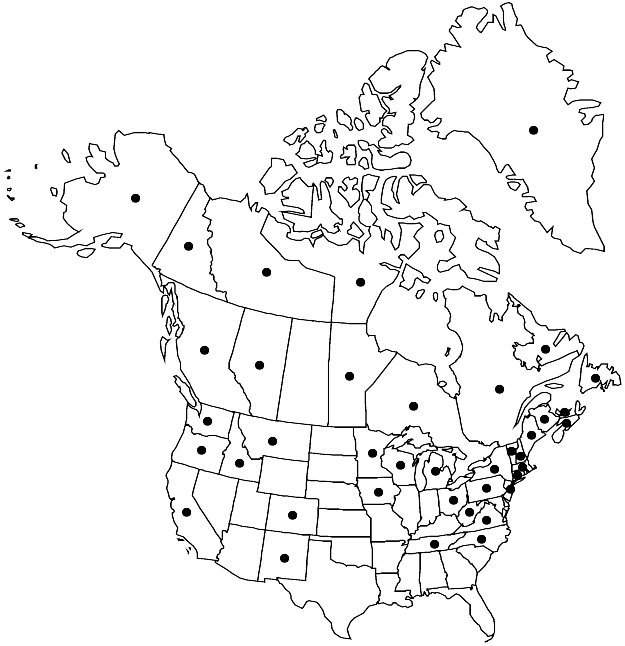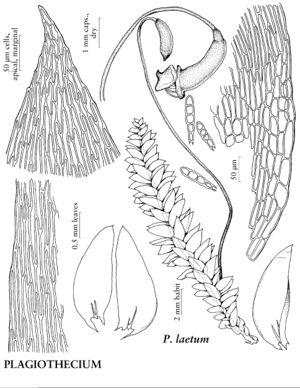Plagiothecium laetum
in P. Bruch and W. P. Schimper, Bryol. Europ. 5: 185, plate 495. 1851.
Plants in dense mats, light green to yellowish, glossy. Stems to 2 cm, 1–3 (–4) mm wide across leafy stem, prostrate, complanate-foliate or rarely somewhat julaceous. Leaves erect or spreading, sometimes secund with apices pointing toward substratum, imbricate or rarely distant, oblong-ovate or ovatelanceolate, asymmetric, flat, often slightly undulate, 0.7–2.6 × 0.3–1.2 mm; margins plane or often narrowly recurved nearly to apex, entire or sometimes with few serrulations at apex; apex slender-acuminate, not abruptly contracted; costa ending just beyond leaf base or rarely with one branch to mid leaf, sometimes ecostate; alar cells rectangular, 40–100 × 9–29 µm, in 1–5 vertical rows, terminating in 1 cell at base, region triangular; medial laminal cells 96–168 × 4–10 µm. Specialized asexual reproduction usually present as propagula, 40–86 × 8–14 µm, of 3–6 cells borne in leaf-axils. Sexual condition autoicous, usually fruiting. Seta orangebrown to red, 1–1.6 cm, straight or curved. Capsule erect to cernuous, light-brown to orangebrown when mature, straight to arcuate, 0.5–2 × 0.4–0.7 mm, smooth when dry or rarely wrinkled at neck when arcuate; operculum conic to short-rostrate, 0.3–0.8 mm; endostome cilia 1–3, sometimes absent. Spores 9–14 µm.
Phenology: Capsules mature summer.
Habitat: Coniferous woods on rotten logs, stumps, base of trees, humus, soil, overlying boulders and cliffs
Elevation: low to high elevations (100-3100 m)
Distribution

Greenland, Alta., B.C., Man., N.B., Nfld. and Labr., N.W.T., N.S., Nunavut, Ont., P.E.I., Que., Yukon, Alaska, Calif., Colo., Conn., Idaho, Iowa, Maine, Mass., Mich., Minn., Mont., N.H., N.J., N.Mex., N.Y., N.C., Ohio, Oreg., Pa., Tenn., Vt., Va., Wash., W.Va., Wis., Europe, Asia
Discussion
Plagiothecium laetum has a history of being confused with P. denticulatum in North America (R. R. Ireland 1969b). Plagiothecium laetum can be distinguished by its small leaves, 0.7–2.6 mm, with narrow medial laminal cells, 4–10 µm, triangular decurrencies composed of rectangular cells, and usually smooth capsules; Plagiothecium denticulatum has larger leaves, 1.5–4 mm, broader medial cells, 12–21 µm, usually oval decurrencies composed of some oval cells, and capsules striate when dry. This treatment includes P. curvifolium in the synonymy of P. laetum. Plants referred to P. curvifolium have smooth, secund leaves pointing toward the substratum, decurrencies of 3–5 rows of cells, composed of rectangular cells mixed with some inflated, quadrate or spheric medial cells, and capsules usually cernuous and often arcuate. These characters do not always correlate, and the plants seem best considered environmental forms of the variable P. laetum.
Selected References
None.
Lower Taxa
"broad" is not a number.
